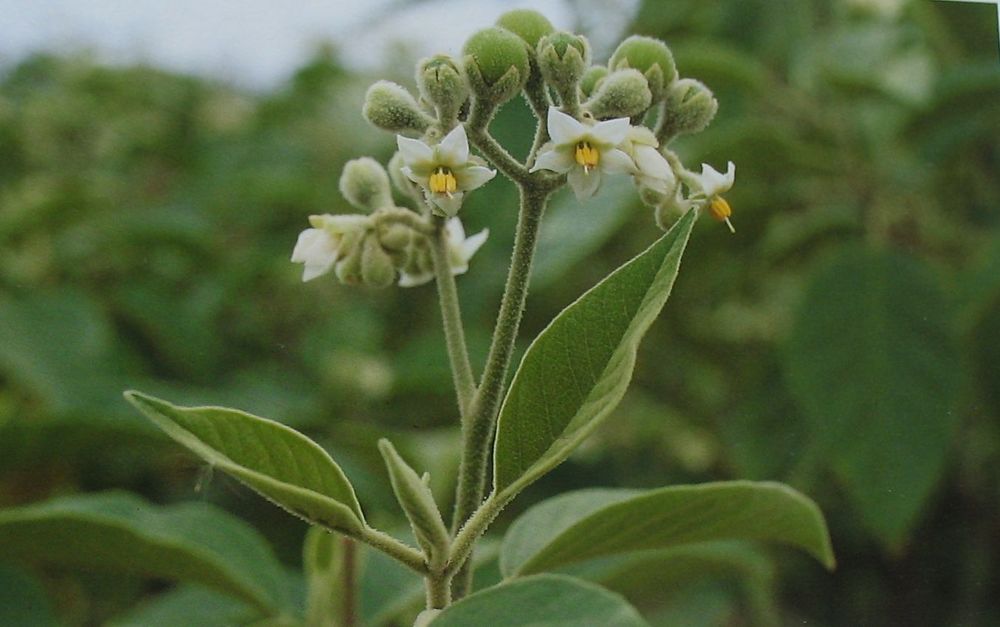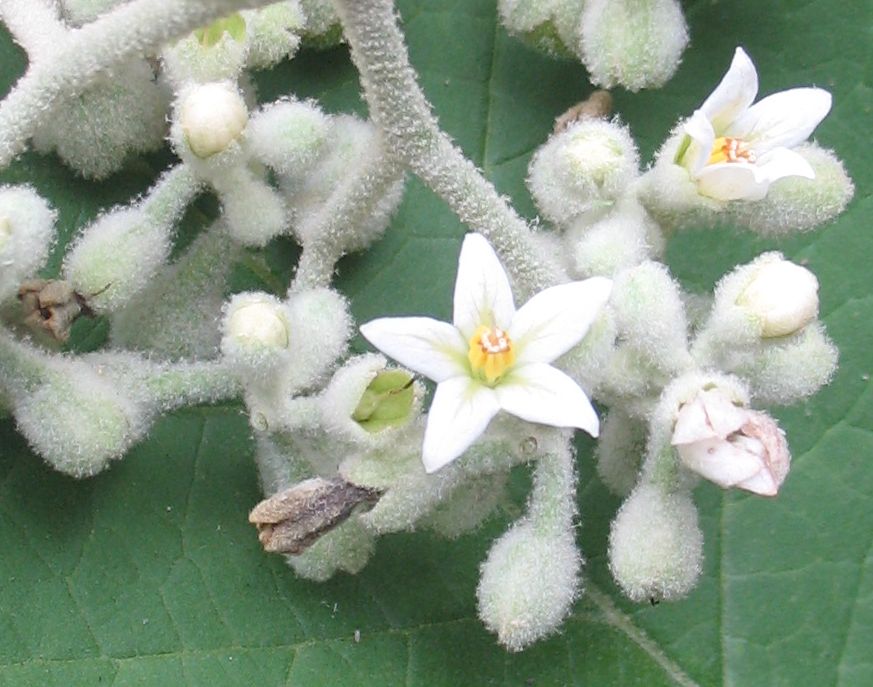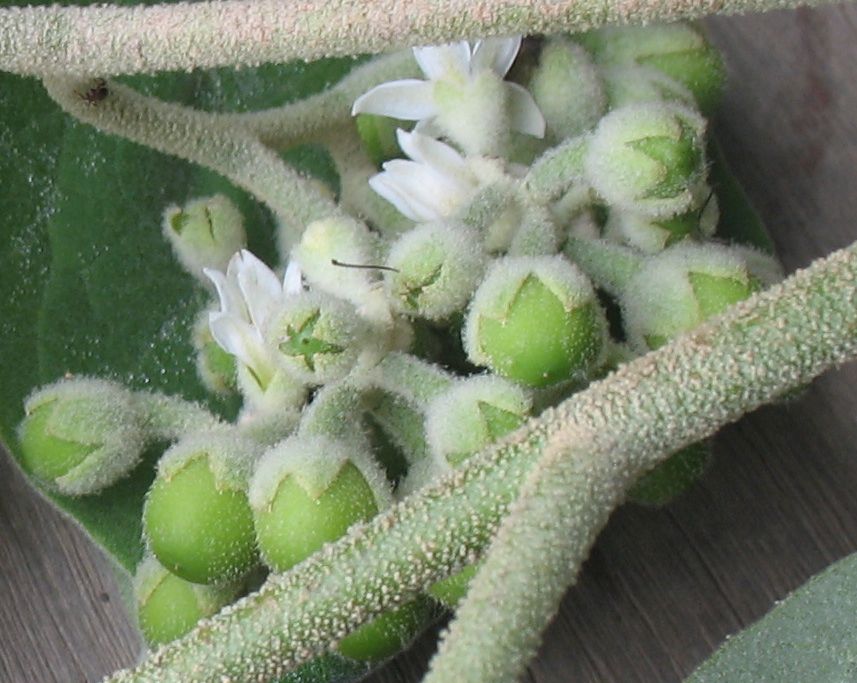Taller than most other Solanum, this one also comes from America, more precisely from the Gulf of Mexico; from there it was introduced by the Spaniards, in the 16th century, to the Philippines and then spread throughout South-East Asia where it quickly colonised abandoned spaces.
Solanum erianthum is an evergreen shrub or small tree, 2-8 metres tall; it grows quickly and produces a small, thin grey trunk with a spreading crown that overhangs the surrounding bushes. Its leaves are simple and alternate, large and oval. Its flowers are grouped in clusters and hang from the end of the branch; they have 5 white petals and 5 yellow stamens. The fruit is an orange berry of 1 to 2 cm containing many seeds. The whole plant is covered with small hairs which give it a fluffy appearance.
This explains the name of the species “erianthum” which means “hairy” and as the aubergine is often considered the representative of the genus the French call it “aubergine poilue”. The English call it a Potato Tree because it is said that the broken roots have the smell of cooked potato. In Laos its names are numerous: sa pèng, sang mong phèng which evoke both the elephant and the powder!
And indeed, the main use given to us is as a powder made from the leaves. This powder is yeast that is added to the rice to ferment it and obtain rice beer and then rice alcohol. The story goes that the birds that come to drink the water accumulated in the hollows of the leaves of sa pèng make a particularly lively song, so the men thought that there was a source of joy in the plant and used it to make their alcohol. This powder added to saltpetre is also used as gunpowder. It should also be noted that the soft wood of the plant makes good charcoal. As with all species of this genus, there are a large number of medicinal uses for S. erianthum. In Laos, a decoction of the roots is given in cases of pain, digestive disorders, irregular menstruation and venereal diseases. The plant is also reputed to treat buffaloes; when they remain in the water for too long they catch leeches that bother them in the nostrils; to relieve them, a juice made from the crushed fruits and leaves is then instilled.
Plus haute que la plupart des autres Solanum, celle-ci vient aussi d’Amérique, plus précisément du pourtour du golfe du Mexique; de là elle aurait été introduite par les Espagnols, au XVIème siècle, aux Philippines et se serait ensuite répandue dans toute l’Asie du Sud-Est où elle colonise rapidement les espaces abandonnés.
Solanum erianthum est un arbuste ou petit arbre de 2 à 8 mètres, toujours vert; il pousse vite et produit un petit tronc gris et mince surmonté d’une cime étalée qui dépasse les buissons environnants. Ses feuilles sont simples et alternes, grandes et ovales. Ses fleurs groupées en grappes penchent leur corolle en bout de branche; elles ont 5 pétales blancs et 5 étamines jaunes. Le fruit est une baie orange de 1 à 2 cm contenant de nombreuses graines. Toute la plante est couverte de petits poils qui lui donnent un aspect plucheux.
On comprend ainsi le nom de l’espèce « erianthum » qui signifie « poilu » et comme l’aubergine est souvent considérée comme la représentante du genre le français la nomme aubergine poilue. Les Anglais disent “Potato Tree” car il paraît que les racines brisées ont l’odeur de la pomme de terre cuite. Au Laos ses noms sont nombreux: sa pèng, sang mong phèng qui évoquent à la fois l’éléphant et la poudre !
Et en effet, l’usage principal qui nous a été donné est celui d’une poudre faite à partir des feuilles séchées. Cette poudre est une levure que l’on ajoute au riz pour le faire fermenter et obtenir la bière de riz puis l’alcool de riz. Car voici ce que l’on raconte: les oiseaux qui viennent boire l’eau accumulée dans le creux des feuilles de sa pèng font entendre un chant particulièrement vif, les hommes ont alors pensé qu’il y avait dans la plante une source de joie et ils l’ont employée pour faire leur alcool. Par ailleurs, cette poudre ajoutée au salpêtre sert aussi de poudre à fusil. Notons également que le bois tendre de sa pèng donne un bon charbon de bois. Comme pour toutes les espèces de ce genre on répertorie un nombre important d’usages médicinaux de S. erianthum. Au Laos une décoction des racines est donnée en cas de douleur, troubles de la digestion, règles irrégulières, maladies vénériennes. La plante est aussi réputée pour soigner les buffles; lorsqu’ils restent trop longtemps dans l’eau ils attrapent des sangsues qui les gênent au niveau des naseaux; on y instille alors, pour les soulager, un jus fait des fruits et des feuilles écrasés.





Taller than most other Solanum, this one also comes from America, more precisely from the Gulf of Mexico; from there it was introduced by the Spaniards, in the 16th century, to the Philippines and then spread throughout South-East Asia where it quickly colonised abandoned spaces.
Solanum erianthum is an evergreen shrub or small tree, 2-8 metres tall; it grows quickly and produces a small, thin grey trunk with a spreading crown that overhangs the surrounding bushes. Its leaves are simple and alternate, large and oval. Its flowers are grouped in clusters and hang from the end of the branch; they have 5 white petals and 5 yellow stamens. The fruit is an orange berry of 1 to 2 cm containing many seeds. The whole plant is covered with small hairs which give it a fluffy appearance.
This explains the name of the species “erianthum” which means “hairy” and as the aubergine is often considered the representative of the genus the French call it “aubergine poilue”. The English call it a Potato Tree because it is said that the broken roots have the smell of cooked potato. In Laos its names are numerous: sa pèng, sang mong phèng which evoke both the elephant and the powder!
And indeed, the main use given to us is as a powder made from the leaves. This powder is yeast that is added to the rice to ferment it and obtain rice beer and then rice alcohol. The story goes that the birds that come to drink the water accumulated in the hollows of the leaves of sa pèng make a particularly lively song, so the men thought that there was a source of joy in the plant and used it to make their alcohol. This powder added to saltpetre is also used as gunpowder. It should also be noted that the soft wood of the plant makes good charcoal. As with all species of this genus, there are a large number of medicinal uses for S. erianthum. In Laos, a decoction of the roots is given in cases of pain, digestive disorders, irregular menstruation and venereal diseases. The plant is also reputed to treat buffaloes; when they remain in the water for too long they catch leeches that bother them in the nostrils; to relieve them, a juice made from the crushed fruits and leaves is then instilled.
Plus haute que la plupart des autres Solanum, celle-ci vient aussi d’Amérique, plus précisément du pourtour du golfe du Mexique; de là elle aurait été introduite par les Espagnols, au XVIème siècle, aux Philippines et se serait ensuite répandue dans toute l’Asie du Sud-Est où elle colonise rapidement les espaces abandonnés.
Solanum erianthum est un arbuste ou petit arbre de 2 à 8 mètres, toujours vert; il pousse vite et produit un petit tronc gris et mince surmonté d’une cime étalée qui dépasse les buissons environnants. Ses feuilles sont simples et alternes, grandes et ovales. Ses fleurs groupées en grappes penchent leur corolle en bout de branche; elles ont 5 pétales blancs et 5 étamines jaunes. Le fruit est une baie orange de 1 à 2 cm contenant de nombreuses graines. Toute la plante est couverte de petits poils qui lui donnent un aspect plucheux.
On comprend ainsi le nom de l’espèce « erianthum » qui signifie « poilu » et comme l’aubergine est souvent considérée comme la représentante du genre le français la nomme aubergine poilue. Les Anglais disent “Potato Tree” car il paraît que les racines brisées ont l’odeur de la pomme de terre cuite. Au Laos ses noms sont nombreux: sa pèng, sang mong phèng qui évoquent à la fois l’éléphant et la poudre !
Et en effet, l’usage principal qui nous a été donné est celui d’une poudre faite à partir des feuilles séchées. Cette poudre est une levure que l’on ajoute au riz pour le faire fermenter et obtenir la bière de riz puis l’alcool de riz. Car voici ce que l’on raconte: les oiseaux qui viennent boire l’eau accumulée dans le creux des feuilles de sa pèng font entendre un chant particulièrement vif, les hommes ont alors pensé qu’il y avait dans la plante une source de joie et ils l’ont employée pour faire leur alcool. Par ailleurs, cette poudre ajoutée au salpêtre sert aussi de poudre à fusil. Notons également que le bois tendre de sa pèng donne un bon charbon de bois. Comme pour toutes les espèces de ce genre on répertorie un nombre important d’usages médicinaux de S. erianthum. Au Laos une décoction des racines est donnée en cas de douleur, troubles de la digestion, règles irrégulières, maladies vénériennes. La plante est aussi réputée pour soigner les buffles; lorsqu’ils restent trop longtemps dans l’eau ils attrapent des sangsues qui les gênent au niveau des naseaux; on y instille alors, pour les soulager, un jus fait des fruits et des feuilles écrasés.










Taller than most other Solanum, this one also comes from America, more precisely from the Gulf of Mexico; from there it was introduced by the Spaniards, in the 16th century, to the Philippines and then spread throughout South-East Asia where it quickly colonised abandoned spaces.
Solanum erianthum is an evergreen shrub or small tree, 2-8 metres tall; it grows quickly and produces a small, thin grey trunk with a spreading crown that overhangs the surrounding bushes. Its leaves are simple and alternate, large and oval. Its flowers are grouped in clusters and hang from the end of the branch; they have 5 white petals and 5 yellow stamens. The fruit is an orange berry of 1 to 2 cm containing many seeds. The whole plant is covered with small hairs which give it a fluffy appearance.
This explains the name of the species “erianthum” which means “hairy” and as the aubergine is often considered the representative of the genus the French call it “aubergine poilue”. The English call it a Potato Tree because it is said that the broken roots have the smell of cooked potato. In Laos its names are numerous: sa pèng, sang mong phèng which evoke both the elephant and the powder!
And indeed, the main use given to us is as a powder made from the leaves. This powder is yeast that is added to the rice to ferment it and obtain rice beer and then rice alcohol. The story goes that the birds that come to drink the water accumulated in the hollows of the leaves of sa pèng make a particularly lively song, so the men thought that there was a source of joy in the plant and used it to make their alcohol. This powder added to saltpetre is also used as gunpowder. It should also be noted that the soft wood of the plant makes good charcoal. As with all species of this genus, there are a large number of medicinal uses for S. erianthum. In Laos, a decoction of the roots is given in cases of pain, digestive disorders, irregular menstruation and venereal diseases. The plant is also reputed to treat buffaloes; when they remain in the water for too long they catch leeches that bother them in the nostrils; to relieve them, a juice made from the crushed fruits and leaves is then instilled.
Plus haute que la plupart des autres Solanum, celle-ci vient aussi d’Amérique, plus précisément du pourtour du golfe du Mexique; de là elle aurait été introduite par les Espagnols, au XVIème siècle, aux Philippines et se serait ensuite répandue dans toute l’Asie du Sud-Est où elle colonise rapidement les espaces abandonnés.
Solanum erianthum est un arbuste ou petit arbre de 2 à 8 mètres, toujours vert; il pousse vite et produit un petit tronc gris et mince surmonté d’une cime étalée qui dépasse les buissons environnants. Ses feuilles sont simples et alternes, grandes et ovales. Ses fleurs groupées en grappes penchent leur corolle en bout de branche; elles ont 5 pétales blancs et 5 étamines jaunes. Le fruit est une baie orange de 1 à 2 cm contenant de nombreuses graines. Toute la plante est couverte de petits poils qui lui donnent un aspect plucheux.
On comprend ainsi le nom de l’espèce « erianthum » qui signifie « poilu » et comme l’aubergine est souvent considérée comme la représentante du genre le français la nomme aubergine poilue. Les Anglais disent “Potato Tree” car il paraît que les racines brisées ont l’odeur de la pomme de terre cuite. Au Laos ses noms sont nombreux: sa pèng, sang mong phèng qui évoquent à la fois l’éléphant et la poudre !
Et en effet, l’usage principal qui nous a été donné est celui d’une poudre faite à partir des feuilles séchées. Cette poudre est une levure que l’on ajoute au riz pour le faire fermenter et obtenir la bière de riz puis l’alcool de riz. Car voici ce que l’on raconte: les oiseaux qui viennent boire l’eau accumulée dans le creux des feuilles de sa pèng font entendre un chant particulièrement vif, les hommes ont alors pensé qu’il y avait dans la plante une source de joie et ils l’ont employée pour faire leur alcool. Par ailleurs, cette poudre ajoutée au salpêtre sert aussi de poudre à fusil. Notons également que le bois tendre de sa pèng donne un bon charbon de bois. Comme pour toutes les espèces de ce genre on répertorie un nombre important d’usages médicinaux de S. erianthum. Au Laos une décoction des racines est donnée en cas de douleur, troubles de la digestion, règles irrégulières, maladies vénériennes. La plante est aussi réputée pour soigner les buffles; lorsqu’ils restent trop longtemps dans l’eau ils attrapent des sangsues qui les gênent au niveau des naseaux; on y instille alors, pour les soulager, un jus fait des fruits et des feuilles écrasés.


